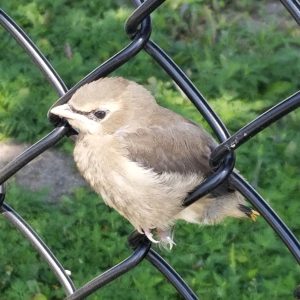 It’s been a good summer for the birds, and there are baby birds everywhere. Perhaps you’ve noticed more chatter as juvenile robins, cardinals, jays, and sparrows beg for food from their parents. Or perhaps you’ve noticed what sounds like familiar song but a bit off-key? That’s the sound of juvenile birds learning and practicing their species’ song!
It’s been a good summer for the birds, and there are baby birds everywhere. Perhaps you’ve noticed more chatter as juvenile robins, cardinals, jays, and sparrows beg for food from their parents. Or perhaps you’ve noticed what sounds like familiar song but a bit off-key? That’s the sound of juvenile birds learning and practicing their species’ song!
It’s quite common to find baby birds on the ground at this time of year. They look helpless and vulnerable and can only fly a few feet at a time, if at all.
We might think that these little ones fell from their nests and need to be “rescued,” but this is generally not the case. Baby birds can’t fly well when they “fledge” (leave the nest): they typically flutter-fall to the ground near their nest and make their way to dense vegetation, where they remain relatively still for several days while mom and/or dad feed them. At this point, they’re relying on camouflage to stay safe from predators and as their wing feathers develop and their flight muscles get stronger. After a week or two, they’ll become more independent and mobile.
What do I do if I find a baby bird on the ground?
In most cases, the best thing to do is to leave the little one alone.
If the bird is naked or almost naked with its eyes closed, its nest was probably disturbed by a predator or weather, and it fell out of the nest early. In this case, I would suggest either leaving it alone (likely to become food for something else… an unpleasant thought, but everything needs to eat to survive) or collecting it, putting it on a towel in a box, and contacting a wildlife rehabilitation centre. The Kawartha Wildlife Centre is a new wildlife rehabilitation centre in Ennismore. At the time of writing, they don’t have their permits to accept injured animals yet, but their website offers advice on what to do when you find an animal.
If the bird is downy with a short tail, “pin” feathers on its wings with some feather sticking out the ends of the pins, and its eyes open, it likely left the nest naturally. If you want to help it, I would suggest doing no more than gently picking it up and putting it on the ground under dense vegetation as close to where you find it as possible. If you have a lot of cats in your neighbourhood (Peterborough has a tremendous number of outdoor cats, both pets and feral, so this is almost certainly the case for you), you might instead place it on a branch a few feet off the ground, instead, also in an area with lots of vegetative cover.
Then walk away and leave it alone.
Pick it up? But won’t mom abandon it if I touch it?
Nope. That’s a myth. Mom won’t abandon her young if you touch them.
Handling them could increase their chances of being eaten by predators, though. Many mammals use their sense of smell to find prey, and several (e.g., cats and perhaps raccoons) associate the smell of humans with food. Bird-eating birds use vision to spot prey, and many are smart enough to associate humans with food (e.g., Blue Jays and American Crows).
So, although a baby bird in the open is vulnerable to predators, touching it can attract mammalian predators, and moving it can attract avian predators, which is why leaving baby birds alone or moving them and leaving the area quickly after moving them is best.
[Photo credit: Baby Cedar Waxwing, Vicki Gray)
